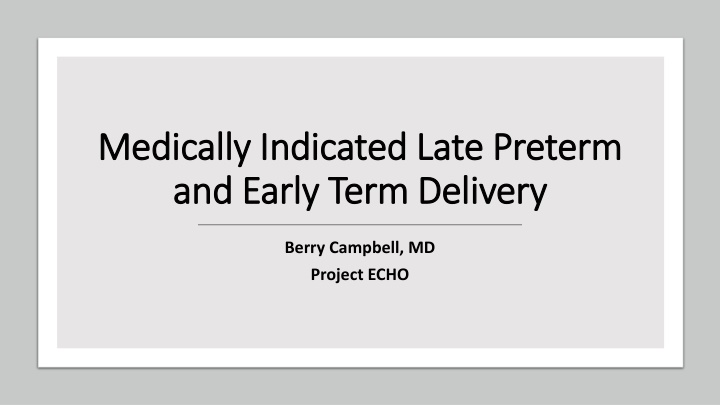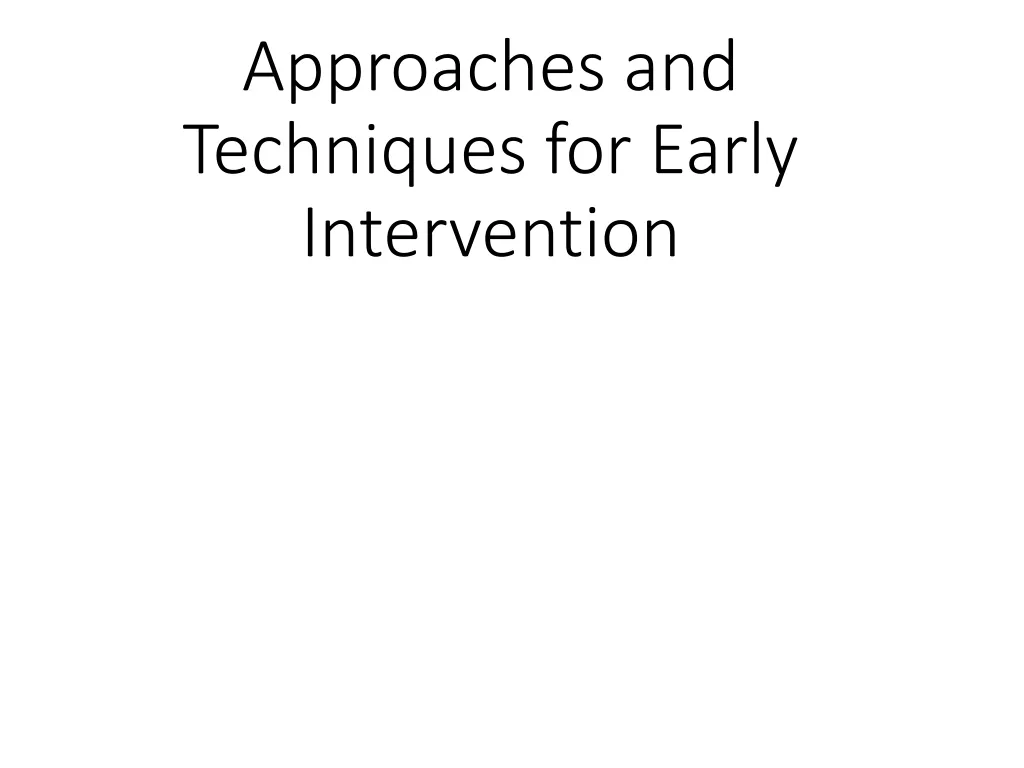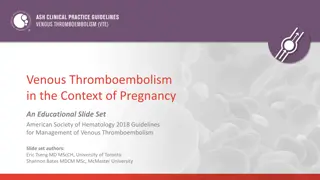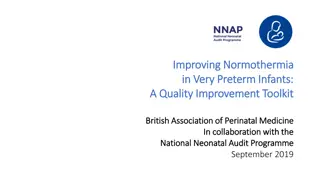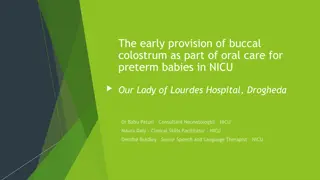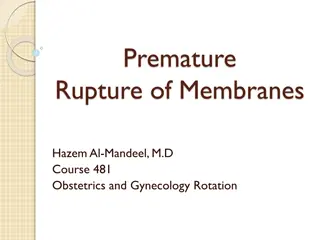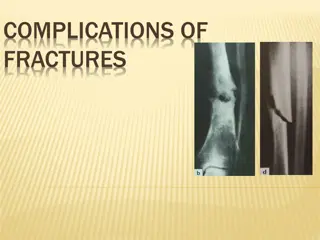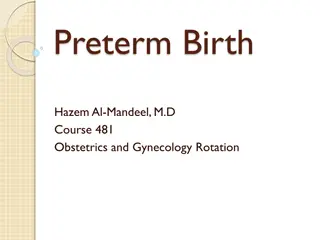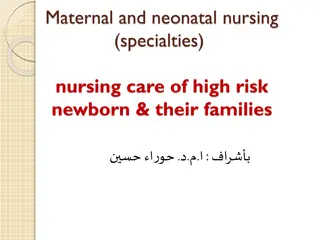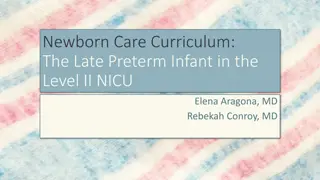Late Preterm and Early Term Delivery: Current Guidelines and Recommendations
Medically indicated late preterm and early term deliveries have evolved over time based on research findings regarding neonatal outcomes. Definitions and guidelines for these delivery periods have been adjusted to consider both maternal and fetal well-being. This article discusses the history, concerns, and current recommendations surrounding the timing of deliveries before 39 weeks of gestation.
Download Presentation

Please find below an Image/Link to download the presentation.
The content on the website is provided AS IS for your information and personal use only. It may not be sold, licensed, or shared on other websites without obtaining consent from the author.If you encounter any issues during the download, it is possible that the publisher has removed the file from their server.
You are allowed to download the files provided on this website for personal or commercial use, subject to the condition that they are used lawfully. All files are the property of their respective owners.
The content on the website is provided AS IS for your information and personal use only. It may not be sold, licensed, or shared on other websites without obtaining consent from the author.
E N D
Presentation Transcript
Medically Indicated Late Preterm Medically Indicated Late Preterm and Early Term Delivery and Early Term Delivery Berry Campbell, MD Project ECHO
When is term considered? Why? When is term considered? Why? In the past, the period from 3 weeks before until 2 weeks after the estimated date of delivery was considered term, with the expectation that neonatal outcomes from deliveries in this interval were uniform and good. Increasingly, however, research has shown that neonatal outcomes, especially respiratory morbidity, vary depending on the timing of delivery within this 5-week gestational age range.
Eunice Kennedy Shriver NICHHD and Eunice Kennedy Shriver NICHHD and SMFM workshop, 2012 SMFM workshop, 2012 Created re-aligned definitions based on neonatal and maternal morbidity with delivery <39 weeks Early term: 37-38 6/7 weeks Full term: 39-40 6/7 weeks Late term: 41-41 6/7 weeks Post term: 42 weeks
Historically Historically 37 week deliveries done for very weak indications 38 weeks considered same as 39 weeks by most obstetricians for convenience Increased concern of respiratory morbidity many amniocentesis for lung maturation studies Awareness of other morbidities ie: neurodevelopmental, feeding, etc unrelated to lung maturation BOTTOM LINE: Elective delivery only if 39 weeks GA; only INDICATED deliveries prior to 39 weeks
Medically indicated late preterm Medically indicated late preterm (34 (34- -36 6/7 weeks)/ 36 6/7 weeks)/ early term (37 early term (37- -38 6/7 weeks) ACOG Committee Opinion #831, July 2021 38 6/7 weeks) Many maternal, fetal, placental complications warranting earlier delivery. Balance benefits/risks Workshop results plus most recent data current recommendations.
Recommendations for the Timing of Delivery When Recommendations for the Timing of Delivery When Conditions Complicate Pregnancy* (continued) Conditions Complicate Pregnancy* (continued) ACOG Committee Opinion 2021, Vol. 138, No. 1
Recommendations for the Timing of Delivery When Recommendations for the Timing of Delivery When Conditions Complicate Pregnancy* (continued) Conditions Complicate Pregnancy* (continued) ACOG Committee Opinion 2021, Vol. 138, No. 1
Recommendations for the Timing of Delivery When Recommendations for the Timing of Delivery When Conditions Complicate Pregnancy* (continued) Conditions Complicate Pregnancy* (continued) ACOG Committee Opinion 2021, Vol. 138, No. 1
Recommendations for the Timing of Delivery When Recommendations for the Timing of Delivery When Conditions Complicate Pregnancy* (continued) Conditions Complicate Pregnancy* (continued) ACOG Committee Opinion 2021, Vol. 138, No. 1
Recommendations for the Timing of Delivery When Recommendations for the Timing of Delivery When Conditions Complicate Pregnancy* (continued) Conditions Complicate Pregnancy* (continued) ACOG Committee Opinion 2021, Vol. 138, No. 1
Case 1 Case 1 36 YO G4 P3003 with a known placenta previa. Prior SVD x 3 Delivery timing? She presents with her 3rd heavy bleeding episode at 35 weeks but has stopped delivery? Wait?
Case 2 Case 2 25 yo G3 P2002 diabetic admitted in second DKA of this pregnancy at 34 weeks Limited PNC A1C at 14 weeks was 8.2; A1C now 10.3. When to deliver?
These recommendations for timing of delivery based on limited data (largely upon expert opinion) thus DECISIONS REGARDING TIMING FOR DELIVERY SHOULD BE INDIVIDUALIZED TO THE NEEDS OF THE PATIENT!
The list IS NOT ALL INCLUSIVE: compilation of commonly encountered indications in clinical practice. Does not include all conditions: uterine dehiscence; chronic placental abruption; etc. Individualized decisions based on best clinical judgement until more data available.
Project ECHO South Carolina Pregnancy Wellness Visit Our Website: https://sctelehealth.org/services/pregnancy-wellness From all of us at Project ECHO SC Pregnancy Wellness, we are wishing you, your family, and friends a peaceful New Year!
